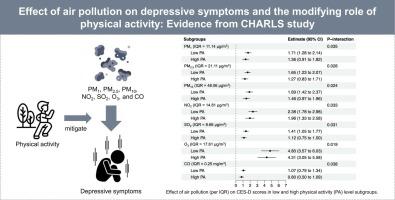空气污染对抑郁症状的影响以及体育锻炼的调节作用:来自 CHARLS 研究的证据
IF 12.2
1区 环境科学与生态学
Q1 ENGINEERING, ENVIRONMENTAL
引用次数: 0
摘要
空气污染与抑郁症状之间的关系尚未得到深入研究,而体育锻炼(PA)的作用尤其引人关注。虽然体力活动有助于缓解抑郁,但也可能导致吸入量增加,从而有可能放大空气污染的不利影响。本研究纳入了中国健康与退休纵向研究(CHARLS)2018 年的 17332 名 45 岁及以上参与者,以评估中国空气污染对抑郁症状的因果效应,并阐明 PA 在这种关系中的作用。抑郁症状根据流行病学研究中心抑郁量表(CES-D)进行评估。颗粒物(PM1、PM2.5 和 PM10)、二氧化氮(NO2)、二氧化硫(SO2)、臭氧(O3)和一氧化碳(CO)的数据来自中国高空气污染物(CHAP)数据集。PA水平通过标准化问卷进行测量,并分为低PA和高PA两类。采用工具变量(IV)法估计空气污染对抑郁症状的因果效应。并进一步分析了 PA 的效应修正。IV估计结果显示,所有空气污染物都对抑郁症状有显著的不利影响,PM1、PM2.5、PM10、二氧化氮、二氧化硫、臭氧和一氧化碳的IQR每增加1.57(95%置信区间(CI):1.15,1.99)、1.49(95% 置信区间:1.10,1.89)、1.71(95% 置信区间:1.26,2.17)、2.22(95% 置信区间:1.62,2.81)、1.30(95% 置信区间:0.96,1.65)、4.67(95% 置信区间:3.37,5.98)和 0.97(95% 置信区间:0.71,1.22)个单位的 CES-D 评分增加。PA水平明显改善了这种关联,PA水平越高,空气污染对抑郁症状的不利影响就越小。本文章由计算机程序翻译,如有差异,请以英文原文为准。

Impact of air pollution on depressive symptoms and the modifying role of physical activity: Evidence from the CHARLS study
The association between air pollution and depressive symptoms has not been thoroughly investigated, and the role of physical activity (PA) is particularly unclear. Although PA has been shown to alleviate depression, it may also increase exposure to air pollution, potentially exacerbating its adverse effects. A total of 17,332 participants aged 45 years and older from the 2018 wave of the China Health and Retirement Longitudinal Study (CHARLS) were included in this study to assess the causal effect of air pollution on depressive symptoms in China and to clarify the role of PA in this relationship. Depressive symptoms were assessed using the Center for Epidemiological Studies Depression Scale (CES-D). Data on particulate matter (PM1, PM2.5, and PM10), nitrogen dioxide (NO2), sulfur dioxide (SO2), ozone (O3), and carbon monoxide (CO) were obtained from the ChinaHighAirPollutants (CHAP) dataset. PA levels were measured using a standardized questionnaire and categorized as low or high. An instrumental variable (IV) approach was used to estimate the causal effect of air pollution on depressive symptoms. Potential effect modification by PA was assessed. The IV estimates showed that all air pollutants were significantly and adversely associated with depressive symptoms, with a per interquartile range (IQR) increase in PM1, PM2.5, PM10, NO2, SO2, O3, and CO associated with 1.57 (95% confidence interval (CI): 1.15, 1.99), 1.49 (95% CI: 1.10, 1.89), 1.71 (95% CI: 1.26, 2.17), 2.22 (95% CI: 1.62, 2.81), 1.30 (95% CI: 0.96, 1.65), 4.67 (95% CI: 3.37, 5.98), and 0.97 (95% CI: 0.71, 1.22) units increase in CES-D scores, respectively. PA significantly modified this association, with higher PA levels mitigating the adverse effects of air pollution on depressive symptoms.
求助全文
通过发布文献求助,成功后即可免费获取论文全文。
去求助
来源期刊

Journal of Hazardous Materials
工程技术-工程:环境
CiteScore
25.40
自引率
5.90%
发文量
3059
审稿时长
58 days
期刊介绍:
The Journal of Hazardous Materials serves as a global platform for promoting cutting-edge research in the field of Environmental Science and Engineering. Our publication features a wide range of articles, including full-length research papers, review articles, and perspectives, with the aim of enhancing our understanding of the dangers and risks associated with various materials concerning public health and the environment. It is important to note that the term "environmental contaminants" refers specifically to substances that pose hazardous effects through contamination, while excluding those that do not have such impacts on the environment or human health. Moreover, we emphasize the distinction between wastes and hazardous materials in order to provide further clarity on the scope of the journal. We have a keen interest in exploring specific compounds and microbial agents that have adverse effects on the environment.
 求助内容:
求助内容: 应助结果提醒方式:
应助结果提醒方式:


